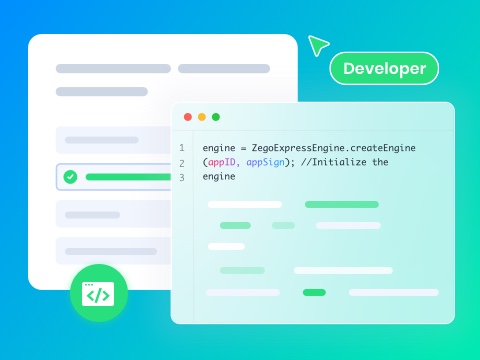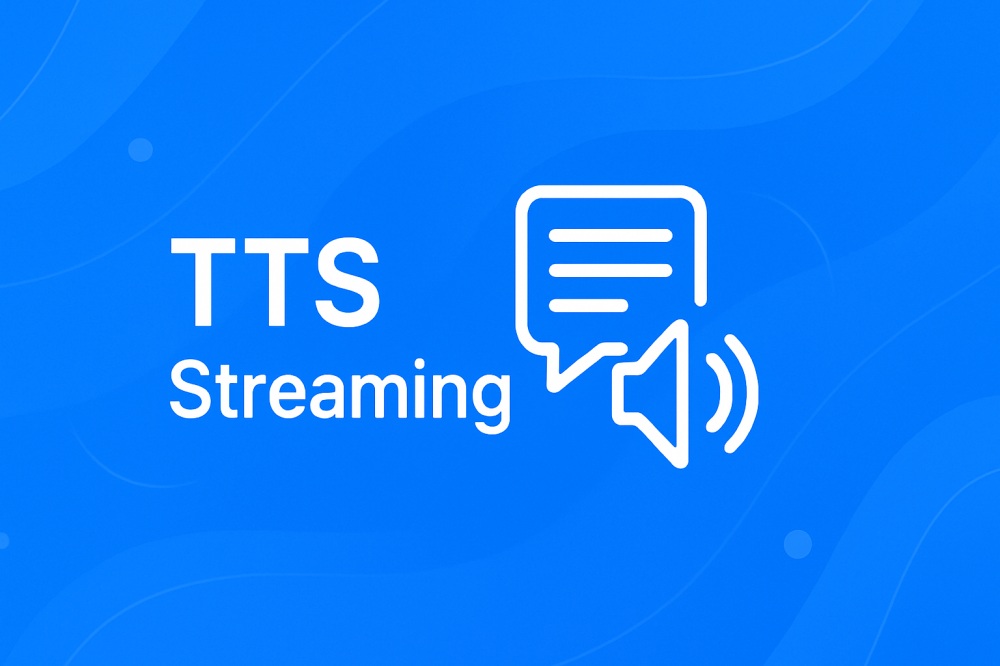TTS streaming is changing the way developers create voice-driven applications. This streaming provides real-time speech rather than letting the user wait hours to generate whole audio files, ensuring a seamless user experience. Therefore, to find out more about it and discover the perfect API, read this guide. We will unveil its advantages, obstacles, and future opportunities to enable you to make a well-informed choice.
What is TTS Streaming?
TTS streaming is an AI technology that is applied in streaming platforms to transform written text into speech in real-time. Moreover, this system will read the messages typed by the viewers using a computer-generated voice so that live streams can be interactive. The technology is widespread in virtual assistants, chatbots, accessibility, and live translation services.
Moreover, AI TTS streaming may provide real-time feedback by reducing the delays, making the streamer more engaged, and enabling the developers to create an interactive experience. Therefore, the experience is more conversational than mechanical despite the inclusion of all these features.
How Does TTS Work?
Many users are interested in understanding how the TTS stream works, as it sparks curiosity among beginners about how this technology converts written messages into spoken words. Therefore, this section offers you detailed insights into its working that you can learn upon diving into the given details:
1. Integration with Streaming Platform
At first, streamers connect a TTS tool or plugin like Streamlabs to their live streaming platform, such as Twitch or YouTube. Furthermore, the system monitors chat in real-time and picks up messages that meet the set criteria, like donations, highlights, and commands.
2. Text Processing and Conversion
When the streamer selects a message, the TTS engines filter it to remove the spam, offensive words, and overly long texts. Moreover, it converts the text into speech using synthetic audio, where modern engines allow customization. They offer tools like different voices, accents, and speaking speeds to let streamers choose one that suits their streaming needs.
3. Real-Time Audio Playback
In addition, when the engines generate voice, the TTS technology turns it into audio and plays it through the streaming software like OBS. Alternatively, some systems offer extra effects like alerts, animations, or sounds when a TTS message plays.
4. Interaction and Monetization
TTS often ties into interactive events such as donation messages or subscriber greetings. Streamers can set rules to moderate content, control how often TTS is triggered, and decide whether it’s open to all viewers or just supporters.
Benefits of Using TTS in Live Streams
Many streamers might not know this, but TTS streaming has numerous perks in the world of streaming. Hence, if you want to learn about a few of them, head to the given details for better clarity:
- Enhanced Viewer Engagement: It encourages participants to send more messages during the live streams as they know their messages will be read aloud. Hence, this makes the stream lively, fun, and interactive while helping viewers to feel directly involved in the broadcast.
- Improved Accessibility: TTS also benefits individuals with conditions such as dyslexia or those who multitask on their mobile phones by reading text aloud. In this way, it makes sure that a larger audience is able to watch the conversation and become a member of the stream community.
- Entertainment and Personalization: AI TTS streaming even adds a touch of humor with funny messages, unique voices, and sound effects. With this, streamers can customize the voice, accents, and styles to create an entertaining streaming experience.
- Boosted Donations and Monetization: If a streamer ties this technology to donations or subscriber actions, it gives viewers an incentive to support the channel. Hence, those messages will become a public “shout-out” and offer support for fun and rewards.
- Community Building: When viewers and streamers hear each other’s messages, they will have the opportunity to connect. Rather than paying heed to text, the streamers will also focus on building a strong connection with their participants to grow their channel.
Key Use Cases of TTS Streaming
The TTS stream has a wide range of applications that go beyond simple chat reading. So, if you want to know where else you can use this technology, review the mentioned use cases:
1. Live Streaming and Audience Interaction
TTS streaming is popular among platforms like Twitch and YouTube Live since chats are read aloud during the broadcast. Hence, this creates lively, interactive streams where viewers compete to get their voices heard. Streamers like xQc or Pokimane use this technology, and their stream contain elements of humor, unpredictability, and stronger community interaction.
2. Virtual Event and E-Learning
Users can also utilize this technology in virtual events, such as webinars, workshops, and online classrooms. To save time and ensure inclusivity, TTS can read typed questions aloud for the speaker and audience. Hence, this fosters more engagement, as seen in the recent example of the “Text to Speech Webinar Part 1” webinar.
Held by Sight and Sound Technology in May 2023, the aim was to facilitate multilingual interaction and improve accessibility for participants.
3. Customer Support and Virtual Assistance
Rather than TTS streaming, users can use this technology in live customer service chats and virtual assistant applications. This offers spoken responses to users’ queries to ensure hands-free and fast support for consumers who prefer listening rather than reading replies. Hence, Voiso is one example that uses TTS directly in its contact center software.
4. Accessibility for Inclusive Viewing
TTS also helps people with visual impairments, dyslexia, or reading difficulties engage with live chats. Besides, it supports multitaskers, like mobile viewers who can listen while doing other activities. Hence, given this significance, some educational Twitch streams, such as CodeBullet’s coding sessions, utilize TTS to enable visually impaired users to hear community queries as well.
5. Gaming and AR/VR Experiences
Players in fast-paced gaming or augmented reality streams do not always have time to read chat. TTS, therefore, addresses this by reading messages aloud on the fly. Players of Beat Saber or VRChat, who use VR, use TTS to listen to chat messages without taking off their headsets.
The Future of TTS Streaming
AI TTS streaming is evolving rapidly, driven by advancements in artificial intelligence and natural language processing. Hence, valued at around $2.93 billion in 2023, it is projected to reach $7.25 billion by 2030 with a CAGR of 13.8%. Furthermore, there are other predictions of slightly different paths, including $6.7 billion in 2032 (11% CAGR) or a more ambitious one of $9.98 billion in 2029 (19.1% CAGR).
Additionally, one of the most important factors is the emergence of neural TTS technology. It took almost 68% of the market share in 2024 due to its almost human quality of voice. This is particularly applicable in the case of streaming and live interaction, where realism is the key. In fact, mobile apps with TTS integration have reported a 30% increase in user engagement, underscoring their impact on interactivity.
Challenges of TTS Streaming
We all know that a coin has two sides, and TTS Streaming is no exception. Despite having significance in numerous industries, it also comes with certain obstacles that are listed below:
- Latency and Real-Time Response: In streaming or webinars, maintaining fast and smooth audio is the primary challenge, but advanced TTS models can introduce delays. Moreover, even a minor bug can disrupt the natural conversion, mainly in gaming and interactive events.
- Naturalness and Expressiveness: Undoubtedly, TTS voices sound much better today; however, they still struggle with emotions and tone when a message is read aloud. Long and emotional conversations feel robotic as most voices lack human-like rhythm and inflection.
- Technical Glitches and Audio Artifacts: TTS during live-streaming can mispronounce words, create abrupt phrases, and produce specific audio glitches. Hence, these issues break the immersion for the audience and make it harder to follow along.
- Computational Demands and Scalability: For a smooth and hassle-free experience, know that TTS requires powerful hardware like GPUs. Thus, when you are running streaming with thousands of participants, it can overload the system and make it hard to balance quality, speed, and cost.
- Ethical and Security Concerns: As TTS voices feel life-like, the risk of misuse also increases with time. Hence, TTS can be exploited for impersonation, deepfakes, or spreading misinformation. Moreover, without strong safeguards, live moderation becomes very challenging, mainly for beginner streamers.
Why ZEGOCLOUD Is the Ideal Partner for AI TTS Streaming
ZEGOCLOUD is a powerful partner for AI TTS streaming due to its ultra-low latency, advanced AI voice technology, strong scalability, and developer-friendly tools. One of its biggest strengths is real-time performance that ensures delivering latency under 300ms to sync AI voices. Additionally, it provides AI-powered voices and effects that guarantee expressive speech, along with fun options like playful effects.
To developers, ZEGOCLOUD provides simple integration with a platform-independent SDK and API. In addition, the platform is scalable and customizable, including 100+ voice packs, global cloud coverage, co-hosting, and real-time analytics. It uses AI noise reduction and high-fidelity audio processing to reduce the background distractions. With CDN, streamers can also add extra content like stats to stream to offer an engaging and immersive experience.
Conclusion
Summing up, TTS streaming makes it easier for streamers to focus on channel building and user engagement with voice-driven interactions. Therefore, this article has shared all the details regarding this technology, including its functionality and benefits. However, for a lag-free experience and life-like voices, ZEGOCLOUD proves to be the ideal partner for AI TTS streaming.
FAQ
Q1: What is TTS Streaming?
TTS Streaming (Text-to-Speech Streaming) is a technology that converts text into natural-sounding speech in real time. Instead of waiting for a full audio file to be generated, users can hear the speech as it is being produced, making it ideal for live interactions and dynamic applications.
Q2: How is TTS Streaming different from traditional TTS?
Traditional TTS usually processes the entire text and outputs a complete audio file before playback. TTS Streaming, on the other hand, generates speech continuously while the text is being processed, enabling ultra-low latency and real-time playback.
Q3: What are the most common use cases of TTS Streaming?
Popular use cases include virtual assistants, customer service bots, online education tools, accessibility solutions for visually impaired users, news reading, gaming character voices, live broadcasting, and conversational AI applications.
Let’s Build APP Together
Start building with real-time video, voice & chat SDK for apps today!










